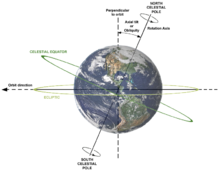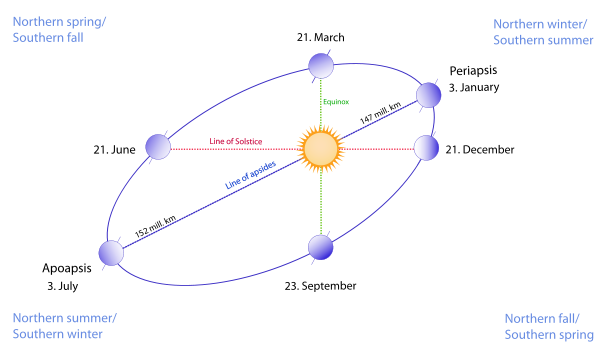Earth Calc
Tags | |
UUID | 3e89839d-e568-11e4-a3bb-bc764e2038f2 |
The Earth Calculator contains a list of constants  "The Blue Marble" photograph
"The Blue Marble" photograph
of Earth, taken during Apollo 17
lunar mission in 1972.and equations related to the planet Earth. The constants have units with automatic conversions between SI and English in most cases. The constants are grouped into Orbital Characteristics and Physical Characteristics.
Earth's Orbital Characteristics
The Orbital Characteristics include constants related to the Earth as a satellite of the Sun including the following:
- Aphelion - Furthest distance from the Sun
- Perihelion - Nearest distance to the Sun
- Semi-major axis - Orbit elliptical parameter
- Eccentricity - Orbit elliptical parameter that defines the shape of the orbital ellipse
- Period - Duration of one complete orbit about the Sun
- Mean orbital velocity - Average instantaneous velocity of the Earth in its orbit around the Sun
- Mean anomaly - Orbital parameter
- Inclination - angle of the Earth's orbit above the Solar System's mean plane (Ecliptic)
- Mean distance to the Sun
Earth'sPhysical Characteristics
The Physical Characteristics include constant related to the Earth as a physical body. These include the following:
- Mean radius
 Earth's axial tilt (or obliquity)
Earth's axial tilt (or obliquity) - Equatorial radius
- Polar (meridian) radius
- Flattening factor
- Circumference at the equator
- Circumference around the poles (meridian)
- Surface Area (total)
- Surface Area (water)
- Surface Area (land)
- Mass
- Mean Density
- Acceleration due to gravity
- Rotational Tilt
- Surface Temperature (min)
- Surface Temperature (mean)
- Surface Temperature (max)
Due to the rotation of the Earth around the polar axis, the Earth can be approximately modeled geometrically as an Oblate Spheroid.
Earth
Earth, also called the world and, less frequently, Gaia (and Terra in some works of science fiction) is the third planet from the Sun, the densest planet in the Solar System, the largest of the Solar System's four terrestrial planets, and the only astronomical object known to accommodate life. The earliest life on Earth arose at least 3.5 billion years ago. Earth's biodiversity has expanded continually except when interrupted by mass extinctions. Although scholars estimate that over 99 percent of all species that ever lived on the planet are extinct, Earth is currently home to 10–14 million species of life, including over 7.3 billion humans who depend upon its biosphere and minerals. Earth's human population is divided among about two hundred sovereign states which interact through diplomacy, conflict, travel, trade and communication media.
is the third planet from the Sun, the densest planet in the Solar System, the largest of the Solar System's four terrestrial planets, and the only astronomical object known to accommodate life. The earliest life on Earth arose at least 3.5 billion years ago. Earth's biodiversity has expanded continually except when interrupted by mass extinctions. Although scholars estimate that over 99 percent of all species that ever lived on the planet are extinct, Earth is currently home to 10–14 million species of life, including over 7.3 billion humans who depend upon its biosphere and minerals. Earth's human population is divided among about two hundred sovereign states which interact through diplomacy, conflict, travel, trade and communication media.
According to evidence from radiometric dating and other sources, Earth was formed around four and a half billion years ago. Within its first billion years, life appeared in its oceans and began to affect its atmosphere and surface, promoting the proliferation of aerobic as well as anaerobic organisms and causing the formation of the atmosphere's ozone layer. This layer and the geomagnetic field blocked the most life-threatening parts of the Sun's radiation, so life was able to flourish on land as well as in water. Since then, the combination of Earth's distance from the Sun, its physical properties and its geological history have allowed life to thrive and evolve.
Earth's lithosphere is divided into several rigid tectonic plates that migrate across the surface over periods of many millions of years. Seventy-one percent of Earth's surface is covered with water, with the remainder consisting of continents and islands that together have many lakes and other sources of water that contribute to the hydrosphere. Earth's poles are mostly covered with ice that includes the solid ice of the Antarctic ice sheet and the sea ice of the polar ice packs. Earth's interior remains active with a solid iron inner core, a liquid outer core that generates the magnetic field, and a thick layer of relatively solid mantle.
Earth gravitationally interacts with other objects in space, especially the Sun and the Moon. During one orbit around the Sun, Earth rotates about its own axis 366.26 times, creating 365.26 solar days or one sidereal year. Earth's axis of rotation is tilted 23.4° away from the perpendicular of its orbital plane, producing seasonal variations on the planet's surface with a period of one tropical year (365.24 solar days).The Moon is Earth's only natural satellite. It began orbiting Earth about 4.53 billion years ago. The Moon's gravitational interaction with Earth stimulates ocean tides, stabilizes the axial tilt and gradually slows the planet's rotation.
References
- wikipedia - en.wikipedia.org/wiki/Earth
Equations and Data Items
Collections
- Comments
- Attachments
- Stats
No comments |
